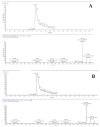An LC-MS Assay to Measure Superoxide Radicals and Hydrogen Peroxide in the Blood System
- PMID: 32354089
- PMCID: PMC7280988
- DOI: 10.3390/metabo10050175
An LC-MS Assay to Measure Superoxide Radicals and Hydrogen Peroxide in the Blood System
Abstract
Red blood cells are constantly exposed to reactive species under physiological or pathological conditions or during administration of xenobiotics. Regardless of the source, its accurate quantification is paramount in the area of theragnostics, which had been elusive up until now. Even if there are a lot of approaches to evaluate the oxidative stress, very sensitive methods are missing for the blood system. We therefore sought to apply a highly sensitive approach, by liquid chromatography coupled to mass spectrometry (UPLC-MS), for the quantification of reactive species such as superoxide radical and hydrogen peroxide using dihydroethidium (DHE) and coumarin boronic acid (CBA) probes respectively through the detection of 2-hydroxyethidium (2OH-E+) and 7-hydroxycoumarin (COH). The use of the high-resolution mass spectrometry associated to UPLC ensured a selective detection of superoxide and hydrogen peroxide in the blood system under diverse conditions such as oxidized red blood cells (RBCs), untreated and treated parasitized RBCs. Moreover, this technique allowed the determination of reactive species in human plasma. This protocol provides a huge opportunity for in-depth study of several pathological conditions vis-a-vis their treatment in modern medicine.
Keywords: Plasmodium falciparum; human plasma; hydrogen peroxide species; liquid-chromatography; mass spectrometry; microvesicles; red blood cells; superoxide radicals.
Conflict of interest statement
The authors declare no conflict of interest.
Figures







Similar articles
-
The development of 1,3-diphenylisobenzofuran as a highly selective probe for the detection and quantitative determination of hydrogen peroxide.Free Radic Res. 2017 Jan;51(1):38-46. doi: 10.1080/10715762.2016.1262541. Epub 2016 Dec 13. Free Radic Res. 2017. PMID: 27866421
-
HPLC-Based Monitoring of Oxidation of Hydroethidine for the Detection of NADPH Oxidase-Derived Superoxide Radical Anion.Methods Mol Biol. 2019;1982:243-258. doi: 10.1007/978-1-4939-9424-3_14. Methods Mol Biol. 2019. PMID: 31172476 Free PMC article.
-
Fast LC-MS/MS analysis of free oxysterols derived from reactive oxygen species in human plasma and carotid plaque.Clin Chim Acta. 2013 Oct 21;425:3-8. doi: 10.1016/j.cca.2013.06.022. Epub 2013 Jul 1. Clin Chim Acta. 2013. PMID: 23827692
-
Ultra high performance liquid chromatography tandem mass spectrometry determination and profiling of prohibited steroids in human biological matrices. A review.J Chromatogr B Analyt Technol Biomed Life Sci. 2013 May 15;927:22-36. doi: 10.1016/j.jchromb.2012.12.003. Epub 2012 Dec 20. J Chromatogr B Analyt Technol Biomed Life Sci. 2013. PMID: 23317577 Review.
-
The challenges of using fluorescent probes to detect and quantify specific reactive oxygen species in living cells.Biochim Biophys Acta. 2014 Feb;1840(2):730-8. doi: 10.1016/j.bbagen.2013.05.004. Epub 2013 May 10. Biochim Biophys Acta. 2014. PMID: 23665586 Review.
Cited by
-
Human Serum Extracellular Vesicle Proteomic Profile Depends on the Enrichment Method Employed.Int J Mol Sci. 2021 Oct 15;22(20):11144. doi: 10.3390/ijms222011144. Int J Mol Sci. 2021. PMID: 34681804 Free PMC article.
-
Mesenchymal Stem Cell Behavior under Microgravity: From Stress Response to a Premature Senescence.Int J Mol Sci. 2023 Apr 24;24(9):7753. doi: 10.3390/ijms24097753. Int J Mol Sci. 2023. PMID: 37175460 Free PMC article.
-
Oxidation of Erythrocytes Enhance the Production of Reactive Species in the Presence of Artemisinins.Int J Mol Sci. 2020 Jul 7;21(13):4799. doi: 10.3390/ijms21134799. Int J Mol Sci. 2020. PMID: 32646002 Free PMC article.
-
Nanoparticle-Aided Detection of Colorectal Cancer-Associated Glycoconjugates of Extracellular Vesicles in Human Serum.Int J Mol Sci. 2021 Sep 25;22(19):10329. doi: 10.3390/ijms221910329. Int J Mol Sci. 2021. PMID: 34638669 Free PMC article.
-
Association of NQO2 With UDP-Glucuronosyltransferases Reduces Menadione Toxicity in Neuroblastoma Cells.Front Pharmacol. 2021 May 10;12:660641. doi: 10.3389/fphar.2021.660641. eCollection 2021. Front Pharmacol. 2021. PMID: 34040527 Free PMC article.
References
-
- Santo A., Zhu H., Li Y.R. Free radicals: From health to disease. React. Oxyg. Species. 2016 doi: 10.20455/ros.2016.847. - DOI
LinkOut - more resources
Full Text Sources

